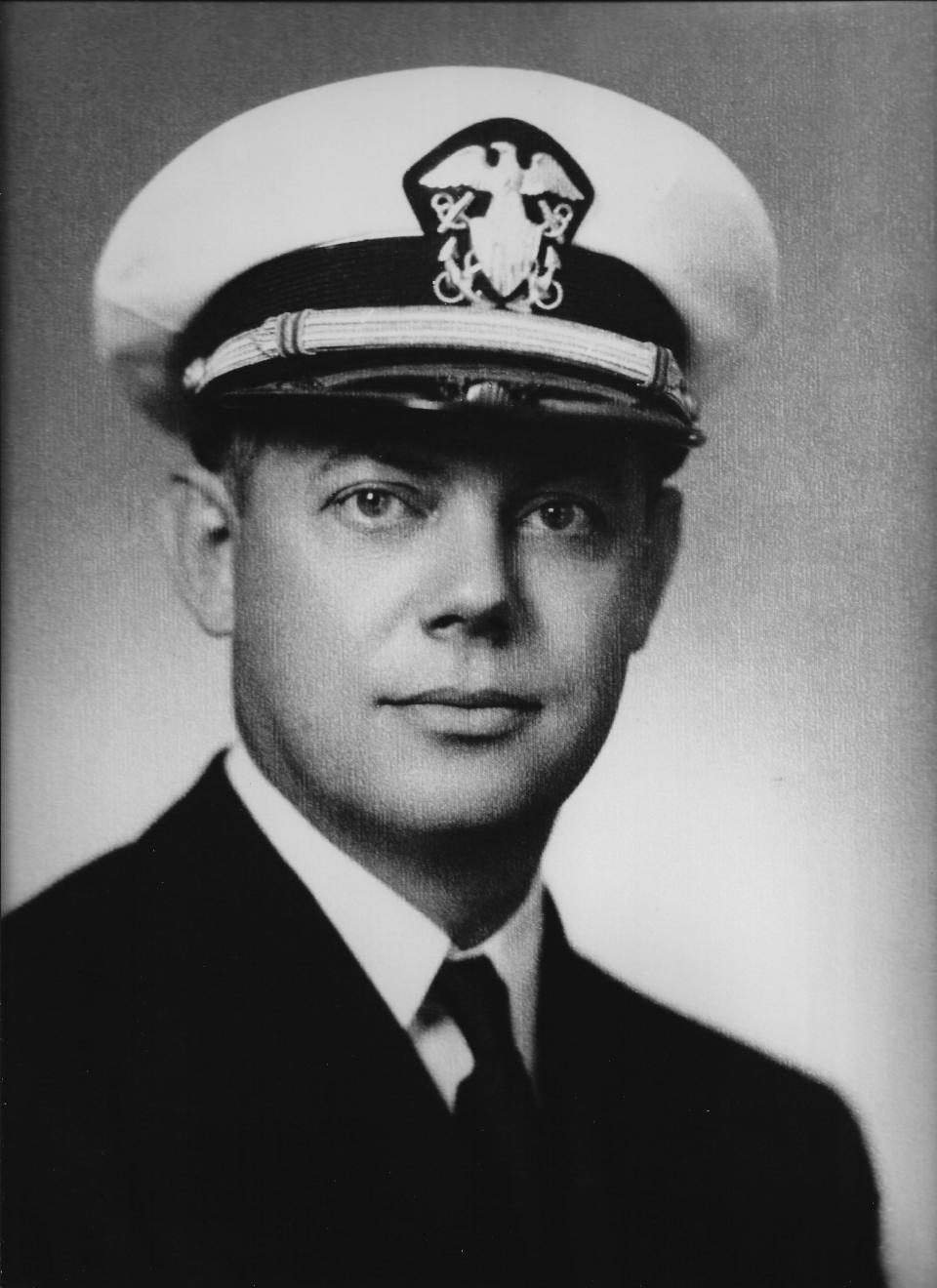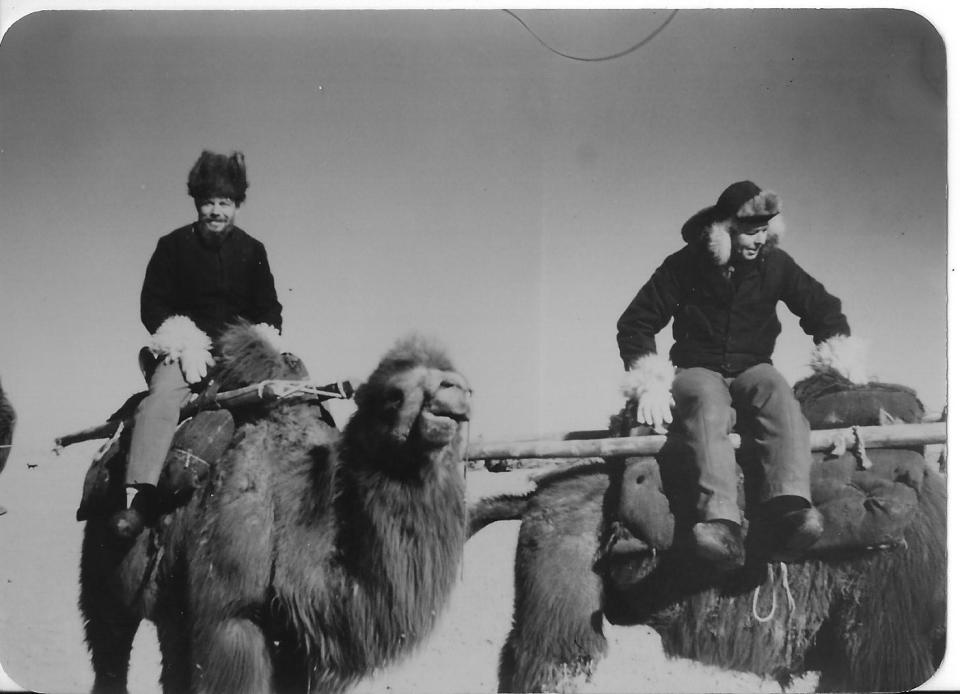December Veteran Flag to honor Robert H. Goodwin, MD
During the month of December, the 40th Lights for Peace flag to fly at the Fort Taber - Fort Rodman Military Museum honors the memory of Robert Hancock Goodwin, MD who served in both the United States Army and then the United States Navy under a secret operation in China known as SACO (Sino-American Cooperative Organization), then continued his career in the Naval Reserve until his retirement in 1961 at the rank of Captain.
Robert was born in East Liverpool, OH, the son of the late Charles F. and Anne (Hancock) Goodwin. He was a 1925 graduate of Princeton University and received his medical degree from Harvard University in 1929. He completed his surgical internship at Boston City Hospital and his residency in obstetrics-gynecology at Boston Lying-in Hospital.
According to his obituary, Goodwin was on the medical staff of the International Grenfell Assoc., Newfoundland-Labrador, in charge of St. Anthony’s, where he opened and ran the first hospital in Cartwright, Labrador from 1932-1934.
He worked as a general practitioner in Freetown from 1934-1935, prior to opening a private practice of obstetrics and gynecology in New Bedford where he practiced for 50 years from 1935-1985. During his tenure at St. Luke’s Hospital, he served as Chief of Obstetrics-Gynecology, Secretary of Staff, and Chief of Staff.

Bob served in the U.S. Army in the 1930s and then entered active duty with the U.S. Navy on August 1, 1942. He went on to serve in a highly secretive unit, known as Unit 4 under SACO, which was an organization “officially approved by Generalissimo Chiang Kai-shek and President Franklin Roosevelt and its articles signed in Washington on April 15, 1943,” according to saconavy.net. The U.S. worked to support the political party fighting against the communist takeover of China and against Japan after the bombing of Pearl Harbor.
The website explained that this “highly secret military operation was commanded by General Tai Li (Head of the Bureau of Investigation and Statistics, i.e. intelligence), as Director and then-Commander (later to become Vice Admiral) Milton Edward ‘Mary’ Miles as Deputy Director. Some of the Americans who walked the seemingly endless berms around the flooded rice fields declared that they had joined a ‘Rice Paddy Navy.’
The Americans lived and worked with the Chinese under cultural conditions previously unknown to each. They became dedicated brothers in arms despite limited knowledge of each other’s language.
Working together within China were about 2,500 American SACO servicemen (of whom 95 percent were Navy, 3 percent Marine, and 2 percent Coast Guard), 97,000 organized Chinese guerrillas, 26,000 pirates in two rival groups, and some lone-wolf saboteurs. They established weather stations, provided vital weather information for the Pacific Fleet, successfully rescued 76 downed aviators, and were involved in numerous military, medical, and humanitarian endeavors. According to U.S. Navy figures, SACO was responsible for the death of 71,000 of the enemy. The Chinese and American members of this outfit were and are known as "SACO Tigers.”
The Saco Navy website explained that the casualty rate was extremely low. Out of the 2,873 members worldwide – including one WAVE (Women Accepted for Volunteer Emergency Service), one French naval officer, and one French army officer – only three were captured and five were killed. None of them died while on active duty in China. “This group probably holds the distinction of being the first American military unit to ever serve under a foreign leader in a time of war.”
"They said it was extra-hazardous, extra-secret, and all-volunteer duty in Asia and it involved parachute-jumping. Nobody on our side knew much about Indo-China. It was a military blank as far as Allied Intelligence was concerned. But through it ran the rail and road supply lines to Japan’s Southeast Asia conquests -the line that would feed any attacks against India, among other things." Goodwin explained, during an interview with the Standard-Times. “To sabotage the rail line and harass other Japanese lines of communication would be a military accomplishment of considerable value. So the idea grew: Drop a party of Americans and others into Indo-China. Besides sabotaging the Japanese, they could pick up information of high interest to Allied leaders."

The article explained that Dr. Goodwin learned things not associated with medicine, from how to blow up a train and demolish a bridge to the use of a submachine gun and close combat fighting, and lastly, parachute jumping, which he completed at a Georgia Infantry camp.
While in China, Dr. Goodwin also provided medical services to Chinese women and refugees. He specialized in gynecology and obstetrics, once delivering a baby by cesarean section with only a candle and flashlight for illumination.
Dr. Goodwin was known to his Chinese patients as Liao Daifu or Old Doctor, which he earned because he had grown a beard. In China, to call a man old is a sign of respect.
Goodwin explained that his unit trained 569 Chinese soldiers in classes of 35 each with courses lasting 10 weeks. American officers were joined by some Chinese leaders. The men were trained in demolition, the use of hand grenades, sabotage, street fighting, and map reading.
According to Goodwin, his unit had no direct contact with other Americans, only radio contact, from November 1943 to January 1945, when General “Mary” Miles flew in for a visit. Shortly after, Goodwin returned home to the United States.
He was discharged in 1946 at the rank of Lieutenant Commander and continued his service in the Naval Reserve until his retirement in 1961 at the rank of Captain. He was awarded the Asiatic-Pacific ribbon with 1-star, American Theater Medal, and the WWII Victory Medal.
Goodwin was featured in the book, "Saco: The Rice-Paddy Navy," by Roy Olin Stratton, a report on the Navy’s China operations.
Dr. Robert Hancock Goodwin, of Dartmouth, died on June 13, 1988, at the age of 85. He was survived by his widow, Doris, A. (Widmayer) Goodwin; a son, Robert H. Jr. of Osterville; two daughters, Anne B. Wagner of Portsmouth, RI, and Susan Goodwin Fera of South Dartmouth; and five grandchildren.
Goodwin was very involved in his community. He was a member of the Wamsutta Club, the Luncheon Club, the Mutual Investment Assoc. of New Bedford, The Old Dartmouth Historical Society, WHALE, and the Rotch-Jones-Duff House. He was also past president of the New Bedford Rotary Club and a Paul Harris Fellow. He was an advisory member of the Council of Coastline Elderly Services and a Dartmouth Town Meeting Member for more than 20 years. He was also a religious man and served as a Deacon and then Moderator of Padanaram Congregational Church.
He was a member of many medical organizations including the American College of Surgeons, American College of Ob-Gyn (a founding fellow); International College of Surgeons, Pan-Pacific Surgical Assoc., Obstetric Society of Boston, the American Medical Assoc., and the Massachusetts Medical Society.
Linda Ferreira, of Empire Ford of New Bedford, researches the life histories of area residents. American flags are provided by Empire Ford of New Bedford. Flags are raised by the staff at Fort Taber - Fort Rodman Military Museum. Those who would like to honor a local veteran in the future can contact Ferreira at lferreira@buyempireautogroup.com.
This article originally appeared on Standard-Times: December Vet Flag honors Cpt. Goodwin

